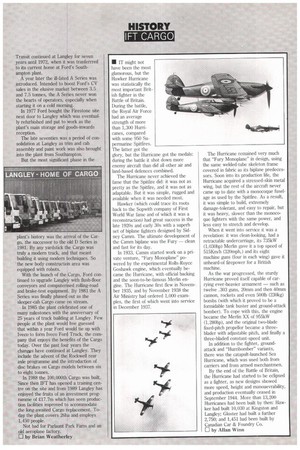• IT might not have been the most glamorous, but
Page 54

If you've noticed an error in this article please click here to report it so we can fix it.
the Hawker Hurricane was statistically the most important British fighter in the Battle of Britain. During the battle, the Royal Air Force had an average strength of more than 1,300 Hurricanes, compared with some 950 Supermarine Spitfires. The latter got the glory, but the Hurricane got the medals: during the battle it shot down more enemy aircraft than did all other air and land-based defences combined.
The Hurricane never achieved the fame that the Spitfire did: it was not as pretty as the Spitfire, and it was not as adaptable. But it was simple, rugged and available when it was needed most_ Hawker (which could trace its roots back to the Sopwith company of First World War fame and of which it was a reconstruction) had great success in the late 1920s and early 30s with a superb set of biplane fighters designed by Sidney Camm. The ultimate development of the Camm biplane was the Fury — clean and fast for its day.
In 1933, Camm started work on a private venture, "Fury Monoplane" powered by the experimental Rolls-Royce Goshawk engine, which eventually became the Hurricane, with official backing and the soon-to-be-famous Merlin engine. The Hurricane first flew in November 1935, and by November 1938 the Air Ministry had ordered 1,000 examples, the first of which went into service in December 1937. The Hurricane remained very much that "Fury Monoplane" in design, using the same welded-tube skeleton frame covered in fabric as its biplane predecessors. Soon into its production life, the Hurricane acquired a stressed-skin metal wing, but the rest of the aircraft never came up to date with a monocoque fuselage as used by the Spitfire. As a result, it was simple to build, extremely damage-tolerant, and easy to repair, but it was heavy, slower than the monocoque fighters with the same power, and less easy to stretch and develop.
When it went into service it was a revelation: it was clean-looking, had a retractable undercarriage, its 735kW (1,030hp) Merlin gave it a top speed of 515Km/h (320mph,) and its eight machine guns (four in each wing) gave it unheard-of firepower for a British machine.
As the war progressed, the sturdy Hurricane proved itself capable of carrying ever-heavier armament — such as twelve .303 guns, 20mm and then 40mm cannon, rockets and even 5001b (230kg) bombs (with which it proved to be a formidable tank buster and ground-attack bomber). To cope with this, the engine became the Merlin XX of 955kW (1,280hp), and the original two-blade fixed-pitch propellor became a threeblader with adjustable pitch, and finally a three-bladed constant-speed unit, In addition to the fighter, groundattack and "Hurribomber" variants, there was the catapult-launched Sea Hurricane, which was used both from carriers and from armed merchantmen.
By the end of the Battle of Britain, the Hurricane had started to be eclipsed as a fighter, as new designs showed more speed, height and manouevrability, and production eventually ceased in September 1944. More than 13,200 Hurricanes had been built by then: Hawker had built 10,030 at Kingston and Langley; Gloster had built a further 2,750; and 1,451 had been built by Canadian Car & Foundry Co.
by Allan Winn




































































































